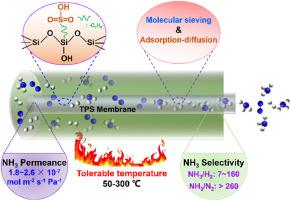当前位置:
X-MOL 学术
›
J. Membr. Sci.
›
论文详情
Our official English website, www.x-mol.net, welcomes your feedback! (Note: you will need to create a separate account there.)
Fabrication of 3-(trihydroxysilyl)-1-propanesulfonic acid membranes with superior affinity and selectivity for NH3 permeation over H2 and N2 at 50–300 °C
Journal of Membrane Science ( IF 8.4 ) Pub Date : 2024-04-19 , DOI: 10.1016/j.memsci.2024.122798 Wei-Wei Yan , Kotaro Wakimoto , Norihiro Moriyama , Hiroki Nagasawa , Masakoto Kanezashi , Toshinori Tsuru
Journal of Membrane Science ( IF 8.4 ) Pub Date : 2024-04-19 , DOI: 10.1016/j.memsci.2024.122798 Wei-Wei Yan , Kotaro Wakimoto , Norihiro Moriyama , Hiroki Nagasawa , Masakoto Kanezashi , Toshinori Tsuru

|
Ammonia (NH) produced by Haber-Bosch process is separated through the condensation process, which needs a large amount of energy consumption. Membrane separation technology is compelling for achieving energy-saving and efficient NH separation. Therefore, 3-(trihydroxysilyl)-1-propanesulfonic acid (TPS) was applied, for the first time, to fabricate sulfonic silica-based membranes and evaluated for NH selective permeation. The amorphous siloxane network can be formed by simple condensation of silanol () under sulfonic acid () self-catalysis, as confirmed by the results of Fourier transform infrared spectroscopy and X-Ray diffractometry. Moreover, TPS xerogel powders dried from TPS sols showed excellent thermal stability and dense structure via thermogravimetric and N adsorption analyses. Importantly, an intensive NH adsorption amount of ∼3.0 mmol g for TPS xerogels from NH adsorption and temperature-programmed desorption was twice higher than the reported oxidized (3-mercaptopropyl)trimethoxysilane xerogels (∼1.41 mmol g), which was ascribed to the inherently stronger proton-acidic groups in TPS. Finally, TPS membranes prepared using TPS solutions diluted with ethanol expressed superior NH-selective permeation based on favorable molecular sieving and NH adsorption-diffusion via single and binary gas permeation, especially remarkable NH permeance of ∼2.6 × 10 mol m s Pa and excellent NH/N selectivity of 266 at 300 °C.
中文翻译:

制备 3-(三羟基甲硅烷基)-1-丙磺酸膜,在 50–300 °C 下对 NH3 渗透具有优于 H2 和 N2 的亲和力和选择性
哈伯-博世工艺生产的氨(NH)通过冷凝过程分离,需要消耗大量的能源。膜分离技术对于实现节能高效的NH分离具有重要意义。因此,首次应用3-(三羟基甲硅烷基)-1-丙磺酸(TPS)来制备磺酸硅基膜并评估NH选择性渗透。傅里叶变换红外光谱和X射线衍射结果证实,在磺酸()自催化作用下,硅烷醇()简单缩合可以形成无定形硅氧烷网络。此外,通过热重和氮吸附分析,由 TPS 溶胶干燥的 TPS 干凝胶粉末显示出优异的热稳定性和致密结构。重要的是,TPS 干凝胶在 NH 吸附和程序升温脱附过程中的 NH 强吸附量为~3.0 mmol g,是报道的氧化(3-巯基丙基)三甲氧基硅烷干凝胶(~1.41 mmol g)的两倍,这归因于其固有的吸附量。 TPS 中具有更强的质子酸性基团。最后,使用乙醇稀释的 TPS 溶液制备的 TPS 膜基于有利的分子筛分和通过单一和二元气体渗透的 NH 吸附扩散,表现出优异的 NH 选择性渗透,特别是 ∼2.6 × 10 mol m s Pa 的显着 NH 渗透性和优异的 NH/ 300 °C 时 N 选择性为 266。
更新日期:2024-04-19
中文翻译:

制备 3-(三羟基甲硅烷基)-1-丙磺酸膜,在 50–300 °C 下对 NH3 渗透具有优于 H2 和 N2 的亲和力和选择性
哈伯-博世工艺生产的氨(NH)通过冷凝过程分离,需要消耗大量的能源。膜分离技术对于实现节能高效的NH分离具有重要意义。因此,首次应用3-(三羟基甲硅烷基)-1-丙磺酸(TPS)来制备磺酸硅基膜并评估NH选择性渗透。傅里叶变换红外光谱和X射线衍射结果证实,在磺酸()自催化作用下,硅烷醇()简单缩合可以形成无定形硅氧烷网络。此外,通过热重和氮吸附分析,由 TPS 溶胶干燥的 TPS 干凝胶粉末显示出优异的热稳定性和致密结构。重要的是,TPS 干凝胶在 NH 吸附和程序升温脱附过程中的 NH 强吸附量为~3.0 mmol g,是报道的氧化(3-巯基丙基)三甲氧基硅烷干凝胶(~1.41 mmol g)的两倍,这归因于其固有的吸附量。 TPS 中具有更强的质子酸性基团。最后,使用乙醇稀释的 TPS 溶液制备的 TPS 膜基于有利的分子筛分和通过单一和二元气体渗透的 NH 吸附扩散,表现出优异的 NH 选择性渗透,特别是 ∼2.6 × 10 mol m s Pa 的显着 NH 渗透性和优异的 NH/ 300 °C 时 N 选择性为 266。







































 京公网安备 11010802027423号
京公网安备 11010802027423号